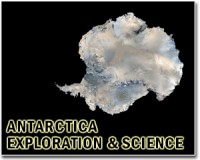 |
London UK (SPX) Feb 23, 2011 By studying collections of a marine bryozoan that date back to a famous 1901 expedition to the South Pole, researchers have found that those organisms were growing steadily up until 1990, when their growth more than doubled. The data, reported in the February 22 issue of Current Biology, a Cell Press publication, provide the highest-latitude record of a century of growth and some of the first evidence that polar carbon sinks may be increasing. The bryozoan in question, known as Cellarinella nutti, is a filter-feeding invertebrate that looks like branching twigs. C. nutti is found in abundance in the Antarctic and is ideal for such studies because it preserves a clear macroscopic environmental record in its skeleton, recorded as tree-ring-like growth-check lines. "This is one of the few pieces of evidence that life in Antarctica has recently changed drastically," said David Barnes of the British Antarctic Survey. "These animals are taking more carbon dioxide out of circulation and locking it away on the seabed." The more rapid growth of C. nutti reflects a coincident increase in the regional production of the phytoplankton that the bryozoan eats. Those algae rely on carbon dioxide dissolved into the seawater for their sustenance. The carbon in the algae is taken up by C. nutti, where it is incorporated into their skeleton and other tissues. As the animals grow, portions of it break off and are buried in the seabed. "Thus, the amount of carbon being buried on the seabed is increasing - whilst globally we are becoming more aware of the need to reduce carbon dioxide in the atmosphere," Barnes said. He says the shift is most likely the result of ozone losses, which have led to an increase in wind speeds over the last decade. Those stronger winds are a boon to plankton, as they blow ice out of the way and drive greater circulation of surface waters. "If we are right, this is a rare example of animals responding to one global phenomenon, the ozone hole, and affecting another, the greenhouse effect," Barnes said. The discovery would not have been possible without early marine collections assembled by the explorer Captain Robert Falcon Scott, a polar pioneer who led the British National Antarctic Expedition and British Antarctic Expeditions at the turn of the 20th century, along with specimens maintained by museums in the United Kingdom, United States, and New Zealand. "Scott's most famous journey was to reach the South Pole, but a team lead by the Norwegian explorer [Roald] Amundsen beat them to it," Barnes said. "Scott's team died in 1912 on the journey back to his food depots, and so his exploits are often not associated with success. What is not so well known is that his voyages were first and foremost scientific ones, and the collections of material and information they made were impressive even by today's standards." The findings highlight the challenges of understanding the effects of large-scale processes such as the ozone hole or climate change. "This is not just because it is patchy in space and time, but also because of interactions between effects, as we found," Barnes said. It is not yet clear how big an impact the changes in C. nutti might have, and at the moment, Barnes suspects it is likely to be quite small. "Nevertheless, we think that the combination of ice shelf losses and sea ice losses due to climate change and the effect of ozone loss-induced wind speeds offer some hope for much-needed carbon sequestration to the seabed in the Southern Ocean," Barnes said. "There are few other places in the world where global and regional changes could actually lead to more carbon being removed from the system."
Share This Article With Planet Earth
Related Links Cell Press Beyond the Ice Age
 Volcanic vents found in Antarctic waters
Volcanic vents found in Antarctic watersSouthampton, England (UPI) Feb 14, 2011 British researchers say the discovery of deep-sea volcanic vents in the Antarctic's Southern Ocean suggests they're more common than previously thought. Deep-sea vents are hot springs on the seafloor, where mineral-rich water nourishes colonies of microbes and animals. Around 250 such vents have been discovered worldwide in the three decades since scientists first encountered the ... read more |
|
| The content herein, unless otherwise known to be public domain, are Copyright 1995-2010 - SpaceDaily. AFP and UPI Wire Stories are copyright Agence France-Presse and United Press International. ESA Portal Reports are copyright European Space Agency. All NASA sourced material is public domain. Additional copyrights may apply in whole or part to other bona fide parties. Advertising does not imply endorsement,agreement or approval of any opinions, statements or information provided by SpaceDaily on any Web page published or hosted by SpaceDaily. Privacy Statement |